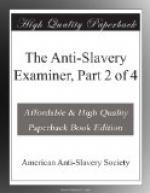But in this narrative the scenes of the plantation rise before us, with a distinctness which approaches reality. We hear the sound of the horn at daybreak, calling the sick and the weary to toil unrequited. Woman, in her appealing delicacy and suffering, about to become a mother, is fainting under the lash, or sinking exhausted beside her cotton row. We hear the prayer for mercy answered with sneers and curses. We look on the instruments of torture, and the corpses of murdered men. We see the dogs, reeking hot from the chase, with their jaws foul with human blood. We see the meek and aged Christian scarred with the lash, and bowed down with toil, offering the supplication of a broken heart to his Father in Heaven, for the forgiveness of his brutal enemy. We hear, and from our inmost hearts repeat the affecting interrogatory of the aged slave, "How long, Oh Lord! how long!"
The editor has written out the details of this painful narrative with feelings of sorrow. If there be any who feel a morbid satisfaction in dwelling upon the history of outrage and cruelty, he at least is not one of them. His taste and habits incline him rather to look to the pure and beautiful in our nature—the sunniest side of humanity—its kindly sympathies—its holy affections—its charities and its love. But, it is because he has seen that all which is thus beautiful and excellent in mind and heart, perishes in the atmosphere of slavery: it is because humanity in the slave sinks down to a level with the brute and in the master gives place to the attributes of a fiend—that he has not felt at liberty to decline the task. He cannot sympathize with that abstract and delicate philanthropy, which hesitates to bring itself in contact with the sufferer, and which shrinks from the effort of searching out the extent of his afflictions. The emblem of Practical Philanthropy is the Samaritan stooping over the wounded Jew. It must be no fastidious hand which administers the oil and the wine, and binds up the unsightly gashes.
Believing, as he does, that this narrative is one of truth; that it presents an unexaggerated picture of Slavery as it exists on the cotton plantations of the South and West, he would particularly invite to its perusal, those individuals, and especially those professing Christians at the North, who have ventured to claim for such a system, the sanction and approval of the Religion of Jesus Christ. In view of the facts here presented, let these men seriously inquire of themselves, whether in advancing such a claim, they are not uttering a higher and more audacious blasphemy than any which ever fell from the pens of Voltaire and Paine. As if to cover them with confusion, and leave them utterly without excuse for thus libelling the character of a just God, these developments are making, and the veil rising, which for long years of sinful apathy has rested upon the abominations of American Slavery. Light is breaking




